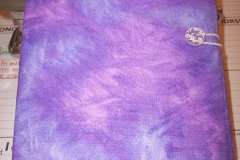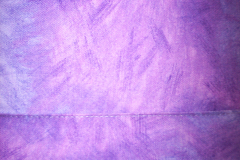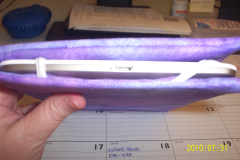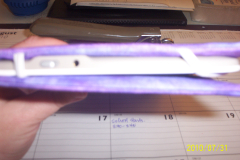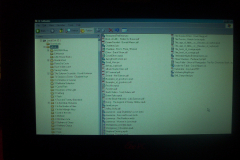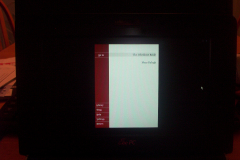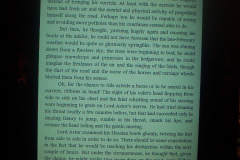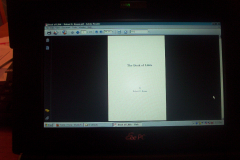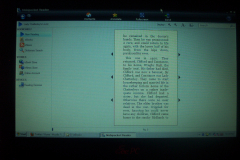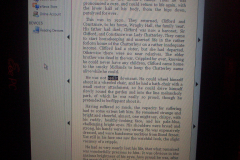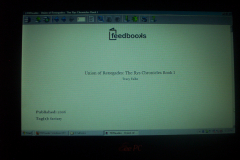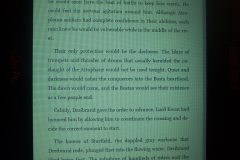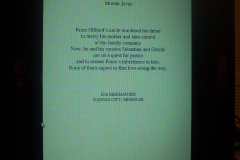When you say stupid shit and read it back almost 2 decades later when you’re cleaning up your blog
Part 4 of a series
ebooks
The value of knowledge

Early adopter rage
[2025-07-24: Blackbird Pie plugin no longer exists, nor do the tweets. Text pulled from backups.]
Dear Berkley, I was all set to buy INDIA BLACK on my Kindle, but it was $9.99. No Effing Way.
twitter.com/#!/MoriahJovan/status/22156474088169472
Dear Big-6 Publishers, it’s not that we’re not buying books. It’s that we aren’t buying YOUR books.
twitter.com/#!/MoriahJovan/status/22157961505800192
I like real books
 I like them on my wall
I like them on my wall
I like them in my hand
(I like them in the bathroom)
I like them on my H: drive
I like them in the car
I like them in a queue
I like them on my laptop
I like them on a shelf
I like them on my keychain
I like them in a library
I like them in English
I like them in bed
I like them on my netbook
I’d like them on a slate, but they’re too heavy.
What is a “real” book, anyway?
“Real” book. As if reading words and being entertained and/or instructed isn’t the point of the damn thing.
I was wrong.
I got a Kindle.
I know. Go ahead and laugh or faint or whatever. I’ll wait until you’ve got yourself back together again.
Long story told in bullet-point lists:
- Saw a Sony at Target. The screen looked like a dot matrix printer (aka like crap). I decided eInk was not for me.
- Amazon pulled some crappy things, which confirmed my opinion of crap.
- My mother-in-law got a Kindle for Christmas and I fondled it. It didn’t look anything like the Sony at Target.
- I couldn’t stop thinking about my MIL’s Kindle.
- I had an increasing need to see what my formatting looked like on the device itself.
- I couldn’t stop thinking about my MIL’s Kindle.
- I had an increasing need to see what my formatting looked like on the device itself.
- Amazon put up their refurbs for $110.
I’ve had it for about a week now. I love it, but I do have some issues and (surprise!) it hasn’t diminished my love for my eBookWise or my BlackBerry. They’re like children: All different, all equally loved for different reasons.
One of my issues with the Kindle is how light and skinny and fragile it is. I know this is supposed to be a plus, but after holding my eBookWise for the last 2-1/2 years, its weight and ergonomic design has spoiled me. The eBookWise feels like a book, only a lot more comfortable.
Anyway, I desperately needed a case for my Kindle to protect it, but geez, people $30? No matter how much I liked my MIL’s case, I figured I could do original-and-cheaper on my own. (Well, hey, that’s how I got into this book publishing business in the first place, my tendency to DIY … everything.)
I’ve made a prototype. I think there are better ways to do this and better designs. I’m going to live with this one for a while and see what I’d change, what other features I might like, a better/more efficient way to build it.
Here’s Prototype Number One (mouse over the pictures to see the commentary):
The perfect bookstore v.2
Go read this and all the comments, then come back. Now we’ll recap.
Footprint: A narrow storefront on the county square of a small midwestern city, with three floors. (I didn’t bother with the third floor sketch. Use your imagination.)
Complaint: It’s not a “real” bookstore.
Disclaimers: 1) I’m not an industrial designer so don’t ding me on scale, lack of bathrooms, and walking space, etc etc etc. 2) This is an IDEA. Don’t take me to task as if I’m on the cusp of taking over the world and implementing all these in a grand sweep tonight while you sleep.
Goal: To make the bookstore a destination, not a stop on your to-do list.
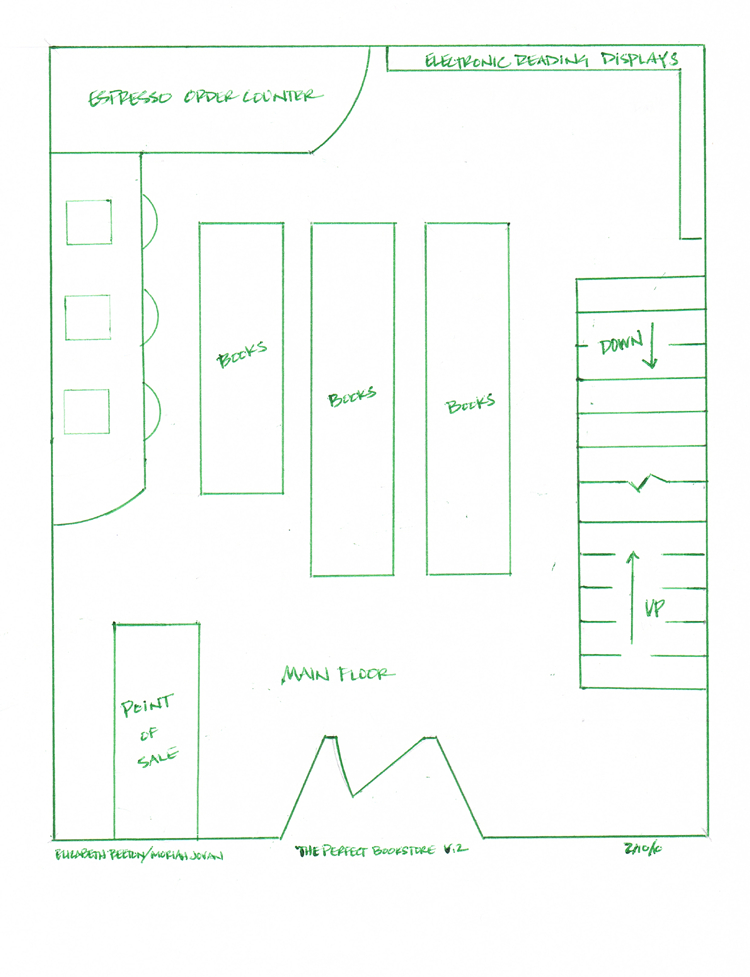
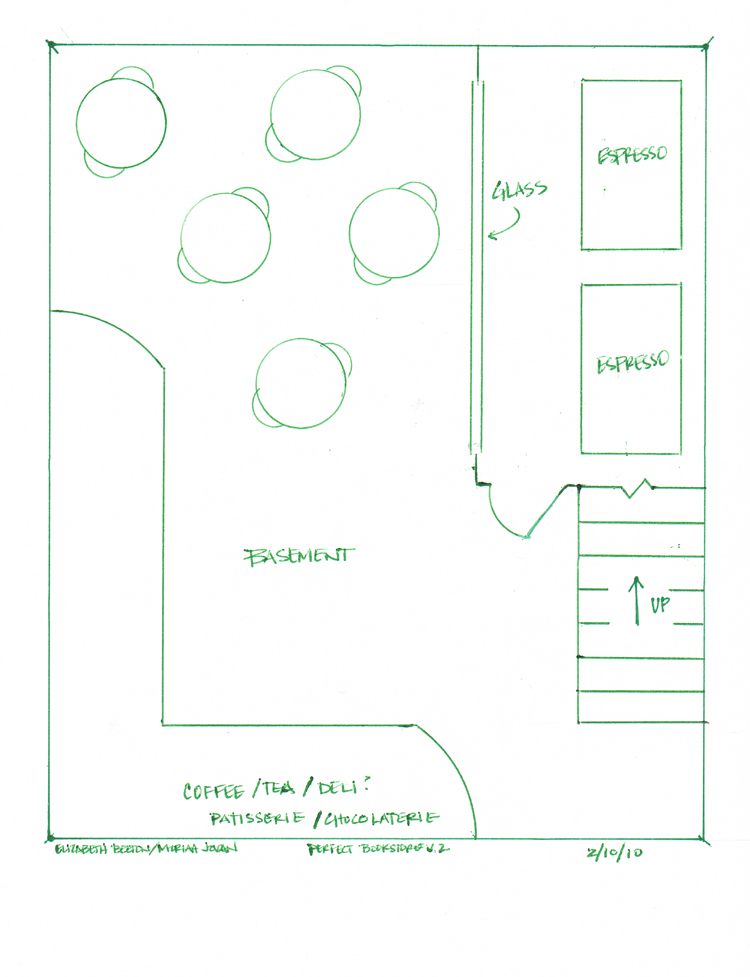
I. Print on Demand
This is the key to blending the Espresso and “real” books:
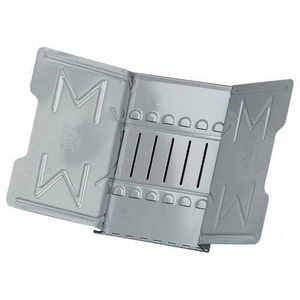
- Do you know what it is? It’s a catalog holder, like the ones at auto parts stores, where you stand at the counter and find which part you need for your car. Only these won’t have catalogs. They’ll have cover flats, separated by genre, subdivided by subgenre.
- You will sit at the counter and flip through them. You will have a little wifi gizmo tied to the store’s computers. You will enter your account number and you will order what you want by pointing the gizmo at the bar code. Your order will go downstairs to the Espresso machines.
- If you want an electronic version, it can be wifi’d do your device and/or you can have a CD/DVD burned, and/or you can have a download link emailed to you.
- If you have already ordered what you want from a home computer or smartphone or other device, it will be waiting for you at the customer service counter (“Espresso Order Counter”).
- The store will have a website that functions like any other ebook third-party retailer.
II. eReading
You may purchase the most current electronic reading devices and be advised by someone who actually knows what they are, how they work, and can teach you. There will be workshops.
III. “Real” books
- The store will have at least one copy of whatever the buyer knows his customers like. He won’t have to order more because he’ll “Espresso it.” That way, customers can browse actual books.
- The third floor will be dedicated to art books, children’s books, collector’s editions, with plenty of comfortable chairs. Yes. You will have to climb stairs. Get over it.
IV. Sustenance
In the basement there will be a coffee/tea bar with pastries and chocolate, possibly a small deli. There will be ample room to hang out.
V. Extras
- You can watch the Espresso machines through the glass window.
- There will be book club nights.
- The Espresso books will always be brought upstairs so you don’t have to go downstairs if you don’t want to.
There you go. Blast away.
iPad
 But does it have wings?
But does it have wings?
Not only is it not a unicorn, it’s not even a Pegasus.
I got your suggestions right here.
The Pareto Principle.
Also known as the 80/20 rule, wherein 80% of sales are generated by 20% of the customers. When applied to the way publishing gambles on blockbusters to subsidize its titles that lose money, it might be more or less 20% of the authors make 80% of the sales.
Publishers look for and sign new authors in a neverending search for the next blockbuster book that will sustain the 20%. Very often a new author will be taken on in favor of renewing a current author’s second or third book if the sales don’t meet expectations (which could mean that it did, in fact, make money, but not enough to satisfy the bean counters).
Last month, I was involved in a rigorous discussion on Dear Author, wherein author Courtney Milan likened publishing’s ability to support this model to pooling risk or, more precisely, flood insurance. I found the flood insurance specificity to be flawed and said why, but really I found the whole “risk pooling” argument flawed, but couldn’t articulate it, so I remained agnostic on the subject for the moment.
Now, after having stewed on it for a while, the better (read: more polite) analogy would be research and development—except without so much the development part.
Recently, president of Farrar, Straus & Giroux, Jonathan Galassi, wrote an extraordinarily unorganized, incohesive rant op ed piece in the New York Times concerning whose rights are whose once the publishing house has put its resources into a manuscript to make it a salable product. Quite frankly, other than the amusing fact that he (an editor) wrote an essay not worthy of a high school freshman learning the basics of English composition, I don’t give a shit about what he thinks the publishers’ value-added rights are.
It was his exemplar of an author long dead, into whom marketing resources were invested to make him that success, that struck me as disingenuous. And a non sequitur. Or ignernt. Dude. You do realize that very few new authors are given these kinds of resources, right? Publishers throw new authors at the wall to see who sticks. There is no “development” counterpart to “research.”
Given that, I’ve moved on from a publisher’s resource allocation to be “risk pooling,” to “research and development,” to “shotgun approach.”
Hang with me—I know I’m only about the 1,537th person to say this, but I do have a point.
So yesterday on Teleread, Rich Adin from An American Editor opined that the way to save publishing is to kill the paperback. When the usual suspects (me) broke out with the usual reaction (Are you out of your fucking mind?), he shot back with, “Well, do you have any better ideas?”
Never mind I have no interest one way or another whether publishing remains profitable, and it’s not my job to put little slips in the suggestion box that will be ignored, and people (readers) have been screaming their fool heads off about what they want which would keep publishing profitable and publishing’s just not paying attention, I will tell you how to keep publishing profitable:
Do less research.
Put a little more development into your research.
Quit getting caught up in auction fever.
Embrace the e-book and treat it as deferentially as you do your other formats and respect those people willing to pay for it. Court them. Cultivate them. They have money to spend on books. Really.
The point is to make every title profitable, or as close to it as you can get.
But I don’t really think you care.
eBookWise
Want an ebook reader but can’t stomach the prices either for the devices, the data plans, or the ebooks?
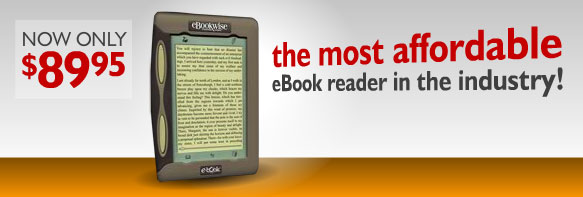 Get an eBookWise.
Get an eBookWise.
See, we all know the biggest objection to all the other devices on the market: Too expensive for a one-trick pony that you’re not even sure you like the trick anyway.
There are the lesser-known problems (until you encounter them): Kindle (could get your library taken away from you, and what if you really don’t like reading on an eInk device?). Nook (apparently shittastic all the way around—if the device can’t read EPUB, it’s an epic fail, trust me). Sony (I’ve heard various and sundry objections to this, so I’ll let you do the googling).
Then there are the people who are waiting on technology to work itself out before they pop for any device, and some of these people are waiting on the iTablet or MSCourier. They still might like to have an ebook reader, but can’t stomach the cost:limitation ratio of any current devices, so they’ll wait until technology catches up to their needs.
Now, it is true that lots and lots and lots of people read ebooks on their BlackBerry et al and iPhone/iTouch. It’s my opinion most people don’t want a one-trick pony device. They want a multifunction device. Why? Because I want a multifunction device and everybody is like me, right?
But … since I’m a cheap bitch and don’t want to fork over for the dataplan for a smartphone, I have a one-trick pony device, and you know what? I love my one-trick pony device. Mike Cane mocks me for it, but the more devices I see rumored, debuted, trashed, complained about, the more I fall in love with my little workhorse. Worse! He sees ebooks (currently) as little more than tarted-up text files (which is true).
So you know what’s so lovely about my little workhorse? It’s $90. That’s right. Know what you give up for that $90? You have to spend a little time learning A) which formats to buy for it and B) perform a few software gymnastics to get it on the device. I mean, for little more than a tarted-up text file, it’s absolutely the most perfect device ever, especially for the price.
Want a starter ebook reader that is ergonomically divine? Backlit so you can snuggle under the covers in the dark and read while staying all warm and toasty? That you can eat and read at the same time? That has a bunch of the same bells and whistles all the expensive devices do, like highlighting, notetaking, mp3 capability (audiobooks), search, long battery life, and the ability to put your own documents on it.
Get the eBookWise.
Really.
I don’t care how sophisticated it’s not. It’s a dream.
I have no connection to this company other than I love its product. I very rarely get so excited about a product and if I do, I very rarely maintain that excitement because eventually its flaws will make me pissy. I’ve had my eBookWise going on 2 years now and I love it more now than I ever did.
I swear, until such a time as A) the iTablet/MSCourier actually appears and B) ebooks cease to be little more than tarted-up text files, I see absolutely no reason to pop for anything else. I’m not anti early adopter. I’m anti early adopter of very expensive but ultimately deficient products in the very thing they are created to do.
And yes, I still have and love my Asus [link], EEE [link], PC [link], but um … it kinda sorta got appropriated by Hero, which is perfectly okay.
UPDATE: Mike Cane’s mockery continues.

He sent me to this picture:

The eBookWise is the one on the far right. It is a blimp, isn’t it? That is exactly why my hands love me for using it instead of anything else (including print). It’s also why it can stand up on the table, propped against a drinking glass, to enable me to read while I’m eating.
An ebook is not a book.
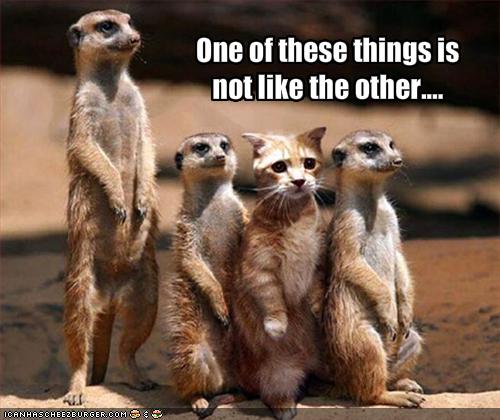 Can we find a word other than “book” as a descriptive for the digital version of glue-and-paper? The word “book” is way too loaded for those who profess a love of “that new book smell” and their reactionary hatred of digital delivery.
Can we find a word other than “book” as a descriptive for the digital version of glue-and-paper? The word “book” is way too loaded for those who profess a love of “that new book smell” and their reactionary hatred of digital delivery.
Print books and digital book are two completely different species. They don’t have to compete. They shouldn’t try to compete. Yes, the content is the same. Yes, the delivery system makes all the difference in the reading experience.
Consider the reading evolution:
Handhewn tablet → papyrus scroll → parchment leaves → illuminated manuscripts → Gutenberg Bible → mass market paperback → computer.
None of those are the same epistemologically or anatomically, so why is the progression to reading digitized text on a handheld device difficult to accept?
Just as a tablet is not a scroll, and a scroll is not an illuminated bundle of leaves, and an illuminated bundle of leaves is not a ream of paper saddlestitched and bound in leather. It is an electronic method of getting to text.
An ebook is not supposed to be like a printed book. Expecting it to be invites frustration on everybody’s part, and completely misses the point
Asus re-redux
I haven’t read any more on the Asus since my last post about it. However, it recently paid for itself when I had a computer emergency. For three days that little thing was an absolute workhorse. It was a little slow and klunky, but it did the job and it kept me earning money. I NEVER expected to need it for that.
So for around $250, I have an emergency work computer, an e-book reader on which I can read ANY DAMN FORMAT I WANT, listen to music, surf the net, keep my data, and write.
And I should buy a Kindle/Sony/Nook/JetBook … why?
More on the Asus
I haven’t used my eBookwise in a while. I’ve been reading *gasp* paper and on my Asus eeePC in my recliner. So last night I went back to my eBookwise.
It’s cold here (well, for early October, it is). It was toasty warm in my bed. I ducked under the covers and read my eBookwise, holding it in one hand (and the ergonomics on this are prescient).
I could not do that with the Asus.
Just sayin’.
The handy-dandy all-purpose digital reader
Some time back ago, I said I wanted an Asus EeePC to read digital books because it was kind of an all-purpose device. As time went on, I decided maybe I’d rather have an iPhone or a BlackBerry, but then I found out about their mandatory data plans and I’m a cheap bitch, so no thanks. I wanted something reasonably portable that I could 1) read digital books on in any format I wanted; 2) listen to music; 3) keep my personal data on (now that I have this awesome personal information management standalone app); and 4) to basically be able to haul my brain around with me. I don’t like talking on the phone, so I would rather not have one at all, but must. I want to keep the phone separate from my other tasks.
Anyhoo, money’s been a little too tight for frills, but then our old (you don’t want to know HOW old) desktops (all three) started nickel’n’diming us to death, so we bit the bullet. I have been given an assignment to return and report the specs and my digital reading experience.
The assignment:
On the Asus, install:
- Adobe Reader
- Adobe AIR
- Adobe Digital Editions (requires AIR, hence 2)
- Microsoft Reader
- MobiPocket Desktop
- Sony eBook Library
- FBReader
Then BLOG wtf it’s like to use them on that Atom CPU. (You DO have ATOM, right, not Celeron?)
ADDITIONAL: Try a GOOGLE BOOKS PDF!!
Here are the specs:
- Asus EeePC 901 (black, if you care)
- Intel Atom
- CPU N270
- 1.6 GHz
- 1.99 GB RAM
- Windows XP Home
- 2-1/2 pounds (about the weight of Atlas Shrugged, I believe)
- ~5 hours battery life (>2 hours better than my Dell laptop)
Here’s a gallery with examples of Adobe Reader, ADE, Microsoft Reader, MobiPocket, and FBReader. I have no reason to care about Sony Reader, but will do later, and I haven’t done a Google Books PDF yet.
So, for the reading part. Thus far, I’ve just been on MobiPocket, reading Soul Identity by Dennis Batchelder, in my recliner. For regular reading, it’s a bit heavy, but if you find your “sweet spot” where you can press the arrow with your thumb and still be comfortable holding it, you get used to it. Naturally, the back light is sweet in the dark.
The only real annoyance I have (besides the weight) so far is how long it takes to turn it on and off. It’s not like my eBookWise, where it’s one button and on, it turns itself off after 15 minutes (or whatever you set). The Asus acts like a computer because, well, it is.
More later after I’ve had a little more time with it.
LDS publishers, again, eBooks. Please!
I went over to Cedar Fort’s blog to look at stuff. Right off the bat, there are two books I wanted to read (okay, so maybe Shannon Hale didn’t traumatize me as much as I thought).
- Altared Plans by Rebecca Cornish Talley
- Deadly Treasure by Jillayne Clements (look at that gorgeous cover!)
Not in digital formats? (Not even Kindle.)
No sale.
Sorry.
Question: Do you LDS publishers realize how many members read their scriptures on their PDAs, SmartPhones, and iPhones? No? The Church gets it. Why don’t you? Maybe you need to venture forth east of the safety of the Rocky Mountains and attend a few wards to find out.
You have no idea how many sales you’re missing out on.
You lost two just with me.
At least, at the very least, get them into Kindle.
I’m cheeky
In case nobody’s noticed, my Perfect Bookstore post has garnered a wee bit of attention here and there around the interwebz, thanks to @RonHogan who linked me in GalleyCat and then Teleread picked me up.
![Tweets between me and @RonHogan on July 7, 2009. Tweet from me: “@RonHogan Dude, you put me on about a gazillion print-book lovers’ hit lists. Heeeee!!!” Reply from @RonHogan: “Heh. And that was after I decided AGAINST titling the post ‘Who is Morian [sic] Jovan And Why Does She Hate Paper Books So Much?’”](https://moriahjovan.com/talesofdunham/wp-content/uploads/2009/07/20090729_ronhogantweet.jpg)
I’ve been to very few of the pingbacks, but of the ones I have, quite a few of them described the post as cheeky.1 I like that. I like that they recognized that instead of presenting it like I was completely serious and the plan/design was complete. I have lots of ideas about a whole lot of things. Most of them are half-assed.
______________________________
1. My vision of “cheeky” is Mary Poppins standing in front of her mirror and lightly chastising her reflection for one-upping her. So, um, for non-regular visitors to the blog, I’m pretty cheeky about everything.
The Bewbies(TM) appear in the Apple store.
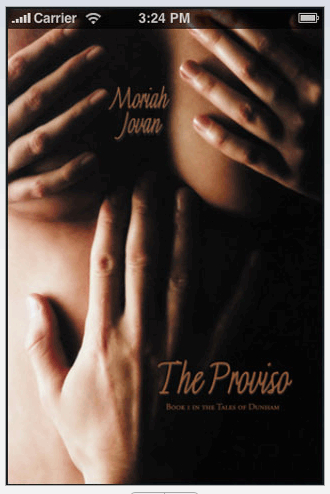
Finally!
After six months, unceasing wailing, and a solid refusal to censor myself, The Proviso was finally approved for sale as an application in the Apple iTunes store.
Go get it!
(Now I don’t feel hypocritical by naming iPhone names in Stay, because, you know, Eric would be on top of all manner of gadgetry.)
PSA for LDS publishers
Y’all probably don’t read my blog. I curse muchly and there is “sex” in my banner, not to mention a bare nekkid lady.
Before you read any further (if you are still reading or the least bit interested), please go to these websites and study them. Ignore the content; I want you to see what they’re doing. Then come back. I’ll wait.
- B10 Mediaworx
- My Bookstore and More (mostly Samhain Publishing’s titles, but look under the “manufacturers” tab and see the other e-book publishers).
- Loose-Id
- Ellora’s Cave
- Baen Books
- Zumaya Books
- eBooks.com
- Project Gutenberg
- Fictionwise
Back? Cool. Now, please go here:
- Amazon Kindle
- Sony e-book reader
- iPhone
- iTouch
- BlackBerry
- Palm Pre
- A more complete list of e-book readers
Did you understand what I wanted you to see? Awesome!
As a consumer of e-books, I would like to offer you a friendly suggestion, which is to embrace the digital distribution of your titles. The e-book publishers I linked are making money hand over fist. The devices I linked are the way people read e-books. This will grow.
You probably don’t understand the seduction of having an entire library in your palm, and that’s okay. There are lots and lots of people who say they won’t give up print for anything, and then they get to live with an e-book reader for maybe two or three days, and they’re hooked.
There’s also something very seductive about being able to log onto an e-bookstore and download a bunch of books onto your device immediately. No driving. It’s all about impulse. I can talk myself out of an Amazon purchase because it involves shipping time. It leaves the shopping cart and goes into the wish list, never to be seen again. I don’t even want to go to a bookstore anymore.
I’ve now encountered three small LDS presses and individuals somewhere in the LDS publishing arena dismiss e-books as so much of a passing fad, a waste of time or, worse, think that “e-book” is synonymous with “PDF.” I simply have to shake my head at their short-sightedness.
Be on the cutting edge of the digital age of books. Take a cue from the church’s rabid embrace of the interwebz and streaming audio and its ability to reach its members nearly effortlessly.
But beyond that, the take-home message here is this: E-bookstores are dangerous to the health of my checkbook.
Want to know the real reason I don’t buy anything from Deseret Book, Zarahemla, Signature Books et al? No e-books. I want to read your books; really I do, but I’m not going back to paper unless you give me something terribly compelling. I buy e-books on impulse. Impulse. Hear that? IMPULSE.
Please give me a reason to throw my money at you in the middle of the night when one of your titles catches my eye. Pretty please?
A cautionary tale for authors and agents
You know, I shove a tanto in my gut and bleed all over the interwebz about my issues with embedded font evangelism in the name of book designer job security, then I get over it and I think I’m done.
Well, Penguin Books has reminded me this morning that not only am I not done, I’m now pissed off as a reader and not as a writer/publisher/e-book mark-up-er, except … this is really not about Teh Pretteh. It’s about DRM. I’m fighting the wrong battle. The book designers can go figure out their own lives. I’m a reader first, dammit.

Way back in the day (six months ago), Penguin offered the novella “You Can Count on Me” by Roxanne St. Clair as a free PDF download you could snag from Ms. St. Clair’s site. It was part of a Christmas anthology called I’ll Be Home for Christmas and features characters from her long-running series called The Bullet Catchers. I believe there are currently three books in this series, with probably more to come.
Now, I don’t like romantic suspense and I don’t like anthologies and I don’t like Christmas romance novellas, but this looked like a good way to ease me into a romantic suspense series that already had me intrigued.
And it was free. No question.
Yet I forgot the cardinal rule of life: There ain’t no such thing as a free lunch.
Dear Penguin:
You suck. And not in the good, hot, naughty kind of way.
The novella is 97 PDF pages long, but it’s 5.25 MB. Why? BECAUSE IT’S A SCAN WITH A BIG FAT KANGAROO WATERMARK ON EACH PAGE.
To give you an idea of how big this is, my 736-page doorstopper’s PDF is 7 MB. 736 pages >97 pages.
I converted this novella before I realized it was a scan. Easy enough. PDF → RTF → IMP.
Except it wouldn’t load onto my eBookWise. WHY WHY WHY? Well, because it’s just too big. The IMP file is 68 MB.
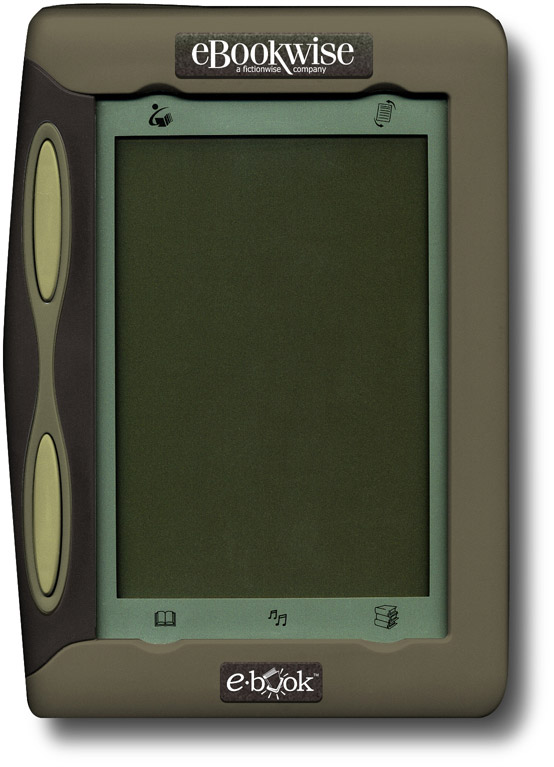
To sum up: Not only am I NOT going to read this free PDF (because I don’t read books on my computer), I’m also going to dump it from my computer (which I never do because even the bad books still belong to me) because it’s a space hog and severely cramps my Vostro’s innards when it tries to open the damned file, and I’m going to remember Ms. St. Clair (poor dear, I know it’s not her fault) for this and only this.
You cost me a lot of time with your chastity-belted freebie, time I could’ve used to make money to buy the anthology the novella came from and buy more of Ms. St. Clair’s work if I liked the novella.
Perhaps authors and agents negotiating contracts with you would do well to remember that your DRM process never gave me a chance to get hooked off your free hit.
Love,
Mojo
Update @8:38 p.m. It was just pointed out to me that the PDF file didn’t actually have any DRM on it. It was just a wildly bloated scanned-and-watermarked PDF. The effect, however, is the same: Make it as difficult as possible for the consumer to read the book. Every time I open the PDF, whatever else is in those graphics (it’s a scan, remember), it nearly crashes my computer.
One could argue that this is where book design and fear of piracy converge to create a virtually (heh) unusable product.
Eating a little bit of crow…
Yesterday, I got a little mouthy (see this post), which will surprise no one.
I was sent an EPUB file that had embedded fonts that rendered perfectly in ADE. I cracked the file open and what did I see? Perfection. The file wasn’t bloated, it was neatly organized, the CSS sheet was reasonably tidy for its detail, and the detail was compact. It worked and it worked beautifully. I can see how it’s done.
In Sony Reader, it mostly rendered the way it was coded (still no full justification).
In FBReader, it did not render the way it was coded at all.
I then cracked open The Proviso file that BookGlutton made. It was a lot leaner; granted, I didn’t have embedded fonts, but it still rendered nicely.
Then I cracked open the file of Stay I had made as an experiment using Atlantis, and it was lean, albeit not as lean as The Proviso because Atlantis broke out each chapter as its own file.
Both The Proviso and Stay look “nice” in ADE, Sony, and FBReader (insofar as anything looks nice in FBReader). That’s right. They look nice. Not spectacular. They do not have Teh Pretteh.
And you know what? That’s okay. I can see that Teh Pretteh EPUB file would take a whole lot more work than I’m willing to invest in either time to hand code or money in software that will do it automatically. I simply see no return on the investment of the extra time for Teh Pretteh with the tools that are available now. I have no doubt that those tools will become available in time.
I’m selling a $40 736-print-page book in 8 ebook formats for $6. The print version is Verra Pretteh, as is the PDF file that comes in the e-book file your $6 buys you. But let’s be real. People who seek out and read e-books—especially on an iPhone, SmartPhone, Kindle, or dedicated reader—are doing it for the content.
After basics: full justification, paragraph indents, line spacing, chapter breaks, a hyperlinked table of contents (and other hyperlinks, if necessary), and those conventions of book reading that move the reader seamlessly through the text, anything else is a waste of time.
Why? Because at the price point that is acceptable to an e-book reader who believes that e-books are cheap to produce and should, then, cost a whole lot less than print books, either A) hand-coding Teh Pretteh or B) purchasing the software that will run Teh Pretteh yields little to no return on investment.
So mea culpa for saying it can’t be done.
No mea culpa for saying it’s a waste of time to do it.
For now.
Yo, EPUB evangelists!
For those of you EPUB designer/evangelists who talk about the way EPUB allows you to embed fonts, listen up: It doesn’t make a damn bit of difference.
The only thing that makes a difference is what the EPUB reader has available to it, to wit: Adobe Digital Editions will display one font and one font ONLY. ITS OWN.
So will Sony reader.
So will FBReader.
You can mark up the text like crazy, but I’m here to tell you, your CSS theatrics is a big fat waste of time. Ask me how I know.
Now, I didn’t set out to become in anywise an expert at this and I’m not and I’m not saying I am. But until such a time as you can make ADE, Sony Reader, and FBReader display your brilliant design, the EPUB “embed font” “feature” is a non-starter.
Remember: People who seek out and read e-books DON’T CARE about fancy design. They care about content and the ease of its readability.

